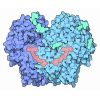+ Open data
Open data
- Basic information
Basic information
| Entry | Database: PDB / ID: 7bam | |||||||||
|---|---|---|---|---|---|---|---|---|---|---|
| Title | human Teneurin4 WT C2 | |||||||||
 Components Components | Teneurin-4 | |||||||||
 Keywords Keywords | MEMBRANE PROTEIN / Synaptic cell adhesion | |||||||||
| Function / homology |  Function and homology information Function and homology informationcardiac cell fate specification / central nervous system myelin formation / synaptic membrane adhesion / positive regulation of myelination / gastrulation with mouth forming second / positive regulation of gastrulation / regulation of myelination / positive regulation of oligodendrocyte differentiation / cardiac muscle cell proliferation / neuron development ...cardiac cell fate specification / central nervous system myelin formation / synaptic membrane adhesion / positive regulation of myelination / gastrulation with mouth forming second / positive regulation of gastrulation / regulation of myelination / positive regulation of oligodendrocyte differentiation / cardiac muscle cell proliferation / neuron development / cell adhesion molecule binding / neuron projection / protein heterodimerization activity / glutamatergic synapse / signal transduction / protein homodimerization activity / nucleus / plasma membrane / cytoplasm Similarity search - Function | |||||||||
| Biological species |  Homo sapiens (human) Homo sapiens (human) | |||||||||
| Method | ELECTRON MICROSCOPY / single particle reconstruction / cryo EM / Resolution: 3.5 Å | |||||||||
 Authors Authors | Meijer, D.H. / Janssen, B.J.C. | |||||||||
| Funding support |  Netherlands, 2items Netherlands, 2items
| |||||||||
 Citation Citation |  Journal: EMBO J / Year: 2022 Journal: EMBO J / Year: 2022Title: Teneurin4 dimer structures reveal a calcium-stabilized compact conformation supporting homomeric trans-interactions. Authors: Dimphna H Meijer / Cátia P Frias / J Wouter Beugelink / Yanthi N Deurloo / Bert J C Janssen /  Abstract: Establishment of correct synaptic connections is a crucial step during neural circuitry formation. The Teneurin family of neuronal transmembrane proteins promotes cell-cell adhesion via homophilic ...Establishment of correct synaptic connections is a crucial step during neural circuitry formation. The Teneurin family of neuronal transmembrane proteins promotes cell-cell adhesion via homophilic and heterophilic interactions, and is required for synaptic partner matching in the visual and hippocampal systems in vertebrates. It remains unclear how individual Teneurins form macromolecular cis- and trans-synaptic protein complexes. Here, we present a 2.7 Å cryo-EM structure of the dimeric ectodomain of human Teneurin4. The structure reveals a compact conformation of the dimer, stabilized by interactions mediated by the C-rich, YD-shell, and ABD domains. A 1.5 Å crystal structure of the C-rich domain shows three conserved calcium binding sites, and thermal unfolding assays and SAXS-based rigid-body modeling demonstrate that the compactness and stability of Teneurin4 dimers are calcium-dependent. Teneurin4 dimers form a more extended conformation in conditions that lack calcium. Cellular assays reveal that the compact cis-dimer is compatible with homomeric trans-interactions. Together, these findings support a role for teneurins as a scaffold for macromolecular complex assembly and the establishment of cis- and trans-synaptic interactions to construct functional neuronal circuits. | |||||||||
| History |
|
- Structure visualization
Structure visualization
| Movie |
 Movie viewer Movie viewer |
|---|---|
| Structure viewer | Molecule:  Molmil Molmil Jmol/JSmol Jmol/JSmol |
- Downloads & links
Downloads & links
- Download
Download
| PDBx/mmCIF format |  7bam.cif.gz 7bam.cif.gz | 689.2 KB | Display |  PDBx/mmCIF format PDBx/mmCIF format |
|---|---|---|---|---|
| PDB format |  pdb7bam.ent.gz pdb7bam.ent.gz | 553.2 KB | Display |  PDB format PDB format |
| PDBx/mmJSON format |  7bam.json.gz 7bam.json.gz | Tree view |  PDBx/mmJSON format PDBx/mmJSON format | |
| Others |  Other downloads Other downloads |
-Validation report
| Summary document |  7bam_validation.pdf.gz 7bam_validation.pdf.gz | 1.8 MB | Display |  wwPDB validaton report wwPDB validaton report |
|---|---|---|---|---|
| Full document |  7bam_full_validation.pdf.gz 7bam_full_validation.pdf.gz | 1.9 MB | Display | |
| Data in XML |  7bam_validation.xml.gz 7bam_validation.xml.gz | 120.8 KB | Display | |
| Data in CIF |  7bam_validation.cif.gz 7bam_validation.cif.gz | 177.3 KB | Display | |
| Arichive directory |  https://data.pdbj.org/pub/pdb/validation_reports/ba/7bam https://data.pdbj.org/pub/pdb/validation_reports/ba/7bam ftp://data.pdbj.org/pub/pdb/validation_reports/ba/7bam ftp://data.pdbj.org/pub/pdb/validation_reports/ba/7bam | HTTPS FTP |
-Related structure data
| Related structure data |  12124MC  7banC  7baoC 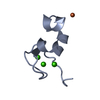 7plpC C: citing same article ( M: map data used to model this data |
|---|---|
| Similar structure data |
- Links
Links
- Assembly
Assembly
| Deposited unit | 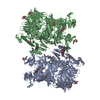
|
|---|---|
| 1 |
|
- Components
Components
| #1: Protein | Mass: 217683.125 Da / Num. of mol.: 2 Source method: isolated from a genetically manipulated source Source: (gene. exp.)  Homo sapiens (human) / Gene: TENM4, KIAA1302, ODZ4, TNM4 / Cell (production host): HEK293E / Production host: Homo sapiens (human) / Gene: TENM4, KIAA1302, ODZ4, TNM4 / Cell (production host): HEK293E / Production host:  Homo sapiens (human) / References: UniProt: Q6N022 Homo sapiens (human) / References: UniProt: Q6N022#2: Polysaccharide | 2-acetamido-2-deoxy-beta-D-glucopyranose-(1-4)-2-acetamido-2-deoxy-beta-D-glucopyranose Source method: isolated from a genetically manipulated source #3: Sugar | ChemComp-NAG / #4: Chemical | ChemComp-CA / Has ligand of interest | Y | Has protein modification | Y | |
|---|
-Experimental details
-Experiment
| Experiment | Method: ELECTRON MICROSCOPY |
|---|---|
| EM experiment | Aggregation state: PARTICLE / 3D reconstruction method: single particle reconstruction |
- Sample preparation
Sample preparation
| Component | Name: human Teneurin4 wt C2 ectodomain / Type: ORGANELLE OR CELLULAR COMPONENT / Entity ID: #1 / Source: RECOMBINANT |
|---|---|
| Molecular weight | Experimental value: NO |
| Source (natural) | Organism:  Homo sapiens (human) Homo sapiens (human) |
| Source (recombinant) | Organism:  Homo sapiens (human) / Cell: HEK293E Homo sapiens (human) / Cell: HEK293E |
| Buffer solution | pH: 7.8 |
| Specimen | Conc.: 0.075 mg/ml / Embedding applied: NO / Shadowing applied: NO / Staining applied: NO / Vitrification applied: YES |
| Vitrification | Cryogen name: ETHANE |
- Electron microscopy imaging
Electron microscopy imaging
| Experimental equipment |  Model: Titan Krios / Image courtesy: FEI Company |
|---|---|
| Microscopy | Model: TFS KRIOS |
| Electron gun | Electron source:  FIELD EMISSION GUN / Accelerating voltage: 300 kV / Illumination mode: OTHER FIELD EMISSION GUN / Accelerating voltage: 300 kV / Illumination mode: OTHER |
| Electron lens | Mode: BRIGHT FIELD |
| Image recording | Electron dose: 50 e/Å2 / Film or detector model: FEI FALCON III (4k x 4k) |
- Processing
Processing
| Software | Name: PHENIX / Version: 1.19.2_4158: / Classification: refinement | ||||||||||||||||||||||||
|---|---|---|---|---|---|---|---|---|---|---|---|---|---|---|---|---|---|---|---|---|---|---|---|---|---|
| CTF correction | Type: PHASE FLIPPING AND AMPLITUDE CORRECTION | ||||||||||||||||||||||||
| Symmetry | Point symmetry: C2 (2 fold cyclic) | ||||||||||||||||||||||||
| 3D reconstruction | Resolution: 3.5 Å / Resolution method: FSC 0.143 CUT-OFF / Num. of particles: 35929 / Symmetry type: POINT | ||||||||||||||||||||||||
| Refine LS restraints |
|
 Movie
Movie Controller
Controller









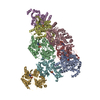
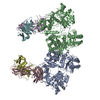

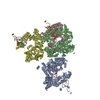

 PDBj
PDBj



